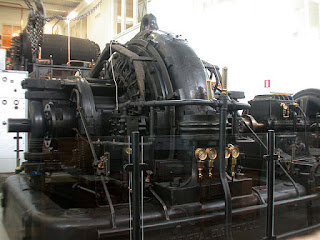A trio of special event stations was on the air in
December to help commemorate different pieces of radio history. On December 11,
N1BCG in Greenwich, Connecticut
made contact on 20 meters in both CW and SSB with GB2ZE in Ardrossan, Scotland,
re-enacting the first successful transatlantic reception of an amateur radio
signal on December 11, 1921. Paul Godley, 2ZE, listening in Scotland, clearly heard signals from 1BCG,
Minton Cronkhite in Connecticut,
on roughly 230 meters (1300 kHz), according to the ARRL Letter. The Radio Club of America
(RCA) - which coordinated the 1921 test - teamed up with the ARRL for the U.S. end of the
2016 re-enactment, while the Radio Society of Great Britain (RSGB) ran the
Scottish end of the link. The 1921 tests helped prove the value of short waves
for long-distance communication.
 |
| The Alexanderson Alternator (see photo credit below) |
On the longwave side of the ledger, historic Swedish
coast station SAQ returned to the air on Christmas Eve, transmitting a message
on 17.2 kHz. The 200-kilowatt Alexanderson alternator (see photo) is activated each year by
the Alexander Association. Special event station SK6SAQ was also on the air on
40 and 20 meters.
Also on Christmas Eve, Brian Justin, WA1ZMS, of Forest, Virginia,
put his experimental 630-meter station WI2XLQ on the air on 486 kHz to mark the
110th anniversary of the first wireless voice and music broadcast by Reginald
Fessenden in 1906. According to the ARRL, Fessenden reportedly played violin
music and read a brief Bible verse.
(Photo by Gunther Tschuch - Own work, CC BY 2.5,
https://commons.wikimedia.org/w/index.php?curid=1071730)
